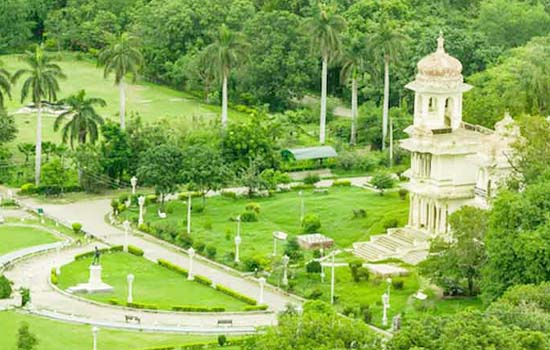
The biggest oxygen pocket in the town that is full of a large variety of trees and flowerbeds located not very for from City Palace, Sajjan Niwas Bagh was laid out due to the initiative of Maharana Sajjansingh. Before this the place was called Gulab Bagh and Bada Bagh. The Maharana got the idea from Ramniwas Bagh, Jaipur. Earlier, near this place there were Badis of Rajrana of Delwara and Rawat of Salumbar and Asind. Some additional land was with Naulakha Bagh and Hanuman Mandir. The Maharana acquired all this land and as compensation, the owners were given land in other areas. Then started the building of the garden in about sixty seven square acre. The old boundary wall was replaced by a new one and roads were built. Drains to carry water from Pichhola lake were constructed. So also a canal from Samore Bagh to Nathulal Ki Badi. For all this, budget of about sixteen thousand was sanctioned by the Maharana.
The Maharana acquired trees and plants of fruits and flowers from places like Saharanpur, Madras and Kashmir and several countries ruled by the British. A large number of trees were useful Ayurved medicinal plants. A separate pool, Kamal Talai was built for lotus plants.
Attracted by the scenic wetland on the bank of Sisarma river and the availability of water from nearby Picchola the Maharana engaged horticulture specialist, European Engineer T. H. Story from Madras to plan and execute the construction of the garden. He was appointed superintendent and was given rupees three hundred per month as salary. He continued till 1920 and then came S.S. Ameta in his place. The work was started in 1881 and later on the garden was developed by Maharana Fatehsingh and Maharana Bhupalsingh. Its official name was Sajjan Niwas Udhyan.
In 1890, Gauri Shankar Ojha was appointed curator of Victoria Hall Museum in the garden. Cricket and football grounds and tennis court were also built. In 1965 started the giving of plants to the public. The bougainvillaea flower plant was planted in 1886 and in six years it rose to the height of seven feet. Vegetables were also grown in the garden and one of the Baoris was called Tarkari Ki Baori. The garden used to be famous for its Banarasi Anwela as the variety was fibreless and white in colour. In 1892 the names of all the plants were written in Hindi and English. Flower show was started in 1887-88.
The foundation of Victoria Hall was laid by Maharana Sajjansingh in 1890 and later on it was inaugurated by Lord Lowsdown. In it were collected rare edicts ranging from third century B.C. to seventeenth century BC. The library has rare and valuable paintings, manuscripts and books of historical importance. On the occasion of silver jubilee of Queen Victoria, the foundation of her statue was laid by Maharana Fatehsingh in 1887. However, later on the statue was replaced by that of Mahatma Gandhi.
One big attraction of the spectacular garden near the western wall of Moti Mahal is a small tank, Pari Ka Haud. The unique architecture of which shows the insight of the builders. There is a small tank near the wall of the Mahal. Above it is a structure with a hollow shape like concave lens and on its upper side is the figure of a blooming lotus. Above it is the figure of an angel with wings wearing ornaments on all the parts of the body like head, neck and arms that are worn in Mewar. The speciality of this statue made with iron and cement is its raised cheeks and open eyes. It holds a fat book in its hands that is open and its pages can be seen from the front. On the left page is engraved a couplet and on the right one a Sanskrit ‘ shloka’ in Devnagri script. Read with the help of a lens, the couplet means that only those who yearn for love can talk about love. The ‘shloka’ seems to be about importance of love.
Another attraction is the statue of a dog under a canopy in the small garden in the west of the statue of Mahatma Gandhi. In the canopy made with stone resting on four pillars can be seen a dog hiding its face with its legs. It is looking out. In fact, the figure is of a bitch. It is said that it was a pet of the royal family and the canopy was built in memory of its qualities like loyalty. The small garden is named Gindakdi Ro Bagh as Gindakdi is the Mewari word for a bitch.
In 1973 was inaugurated a children’s train.Worth a visit in the garden is Navlakha Mahal where Swami Dayanand Saraswati stayed as a state guest for some time and wrote Satyarath Prakash.
There are two lions at the main gate of the garden. The gate in the north side was built by Maharana Bhupalsingh in 1932.
Gulab Bagh used to have a big zoo with tigers, panthers, crocodiles, boars, deer, monkeys, peacocks, ducks etc. but some time back the animals were shifted to Biological Park, Sajjangarh. Now in its place a big bird park is being developed.
True to its name, Gulab Bagh that covers an area of about one acre has about three thousand five hundred rose plants of sixty five kinds of ‘deshi’ and ‘videshi’ flowers. Their colour includes red, yellow, blue and white. The sight very soothing for the eyes and the amazing fragrance attracts a large number of visitors every day including tourists. Morning walk is a pleasant exercise for a big number of Udaipurites. It is also a favourite spot for picnic. On Hariyali Amawas every year, it is thronged by huge crowds.